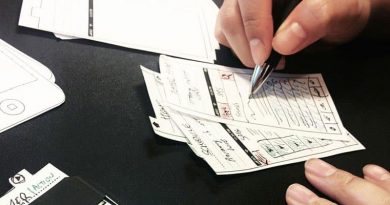How to Use Role-Play Method in UX Research
As human beings, our lives are formed as a net of intersected stories. Reading or watching stories help us to put ourselves on others shoes, feel their pains and pleasant experience. Accordingly, role-play can be one of the effective method in UX research to explore about users’ needs and experience when using the developed product or service.
UX research can be applied to both tangible (products) and intangible (service) solutions. While it is straight forward to explore, test or evaluate tangible products, the task becomes challenging in the case of services. Therefore, trying to visualise how consumers experience the provided service can be the best way to understand about their experience when using the service. The role-play method can fit into the Discover and Develop stages of the design thinking process (see The Double Diamond Design Thinking Process and How to Use it).

Based on this nature of the service products, the role-play method can play a significant role in UX research to build an understanding of consumer needs. Previously, we explored other tools that could be used to explore consumer experience or test services such as:
- The Role of Storytelling in the Design Process
- Visual Guide to the Customer Journey Mapping
- 4 Service Design Tools to Focus on Consumers’ Needs
What is the Role-Play Method?
The role-play is a type of prototyping and active learning technique that helps in improving the UX for a product or service from the audience. Role-play can be used to explore (i.e. brainstorming or reversed brainstorming), gather data and improve user experience (or problem solving) when interacting with a product or service. Based on the data that is gathered, one or more actors represent the interaction with a product or service and the others observe the situation. The role-play is made to give the participants an insight into the user experience with the prototype of the product or service (also check How to use Card Sorting to Improve Service Design).
After the role-play task, the participants gather insights and play out all the other scenarios or re-play the same scenario with variations that can alter the participants’ experience. Re-role playing involves replaying the same part with other participants to better understand how others would act in the same situation. In his paper, Role-play Exercises in User Experience-driven Product Development, Winter explored the application in prototyping.

By role-playing a situation, the participants get an experience in dealing with the issue in real life, as well as the ability to develop quick and accurate reactions to various events. This implies that instead of making mistakes or becoming overwhelmed by events, the participant will be able to react efficiently.
The role-play is effectively used in the design thinking process to explore ideas and test solutions. Check how the role-play is used by the IDEO.
How to Apply the Role Play Method
The role play will give the participants an insight into the UX with the prototype of the product. It is used to evaluate the UX design or concept from different perspectives.
1- Identify the scenario/situation to be studied
To start off, gather all participants and introduce the problem. To identify the scenario, they must have an open discussion to find the relevant issues. This lets them think about the problem before the role-play starts (check other problem solving tools such as TRIZ, 8D, Cause Effect Diagram and CATWOE).
2- Figure out the scenery and the roles involved in the play
Once the scenario is identified, they must figure out the scenes that are needed for the role-play and identify the roles involved in the play. It can be split up into smaller scenarios or can be played as one long scenario. The scenario must be detailed enough for it to be real and make sure all participants are clear about the problem and the scenario.
3- Assign roles
Once you’ve set the storyline and the scenes (check The Role of Storytelling in the Design Process), identify the characters involved in the scenario. Assign these characters/roles to the participants involved in the exercise. It is important for the participants to represents these roles by understanding the perspective, goals and feelings when they enter the situation.
4- Stage the role play
Each participant can imagine their roles and act out the situation by trying different approaches wherever necessary. They could also test and practice various approaches and situations, so the participants get an improved experience in handling the situation.
5- Examine individual insights
After the role-play, it is important to examine individual insights and discuss what they have learned with the role-play. You can discuss on the scenarios and ask for written summaries of observations from everyone who participated in the role-play.
How to Evaluate Role Play in UX Research?
Role-plays are easy to learn and understand and participants can slip into the role of someone else and interact with each other while using their knowledge of user behaviour. However, it is also easy to lose the direction similar to other explorative tools. So, it is crucial for the team to set a clear target and maintain it through the role-play.

This target feeds into the evaluation of the findings and insights concluded of the tool. So, the team reflect on their experience and try to link the findings with the main target of the role-play session. For an effective evaluation of findings, the team needs to consider:
- Adjust tasks with learning outcomes and construct them accordingly.
- Provide clear and the right information as to what is expected of the participants.
- Ensure that the participants are taking full advantage in learning and understanding other participants along with being authentic and real.
Advantages of Using Role Play Tool in UX Research
Comparing with other service design tools, the role-play has a unique nature as it fuels creativity and allows the team to see the problem from a different perspective. Generally, the advantages of using the role play in UX research can be mapped to the following four benefits:
Problem-solving: The role-play improves problem-solving skills within the group. It allows them to understand how the same users may react differently in multiple scenarios or different UX with the same scenario. The group can collaborate and discuss various ways to resolve the situation and it allows participants to gain as much information as possible in similar real-life situations.
Fuels creatively: With multiple participants in the activity, it lets all the participants think and generate ideas quickly. It also lets the participants experiment with their creative vision.
Improves communication and social skills: Actively participating in the role-play requires basic communication skills. Participants are asked to interact within the scenarios they’re given which encourages them to communicate, find solutions and understand what other participants are thinking. The role play lets them improve their collaborative, communication and social skills.
Insights: The participants can get distinct ideas and inputs from other participants. Role playing provides more insights and creates a greater number of scenarios than other ideation methods.
Disadvantages of Role Play Method
To be honest, the role-play tool is a challenging one. Several issues need to be considered in order to apply the tool effectively.
Makes some participants feel uncomfortable: Most participants may not be comfortable with role-plays. Some may feel that the activity is completely for entertainment purposes and may feel anxious if they know there’s a role-play exercise. It can affect their performance and may also make them feel less confident during the role-play.
Time Consuming: The role-play method may be time-consuming as it requires more time for brainstorming, and for the role-play itself. So, it is essential to maintain one accurate target to achieve out of the role-play session.
Books related to role-play method in user experience:
- A Project Guide to UX Design: For user experience designers in the field or in the making
- Don’t Make Me Think, Revisited: A Common Sense Approach to Web Usability
- UX Methods: A Quick Guide to User Experience Research Methods
Conclusion
Actively participating in the role-play shows how the participants real-life behaviour and how passionate they are. The task will give them more insights into evaluating and improving the product or service.
The role-play method must be realistic by doing a natural usability test. The participants must be able to act as they would if they were in the situation. It builds communication and social skills as they work together to solve a problem or address a situation.
The role-playing is a method used to assist design ideation in UX research. When compared to other design ideation methods, roleplay allows natural and real insights as this task can create more scenarios than other ideation methods. Roleplaying also allows richer insights with more details and other possibilities.
Time needed: 3 days
How to apply the role-play method in UX research
- Identify the scenario/situation to be studied
- Figure out the scenery and the roles involved in the play
Define the target of the role-play session and how this target helps in the UX development process.
- Assign roles
Define the different roles between team members. Some participants will play the user role, others will be the system side and others will be observers.
- Stage the role play
Start the role-play exactly as the user expected behaviour. Each choices or scenarios should be separated for clear idea about the situation.
- Examine individual insights
Explore the observed findings and discuss it within the team participants. If needed, the process could be repeated with other scenarios and details.






